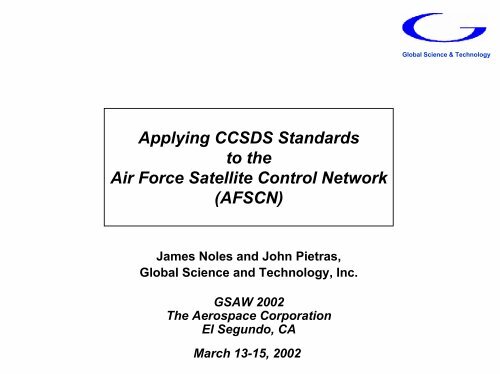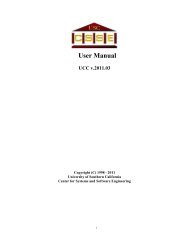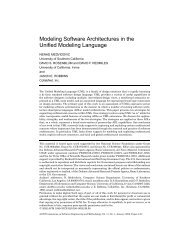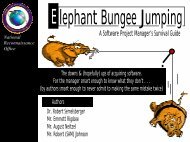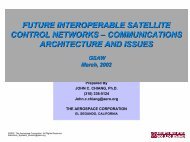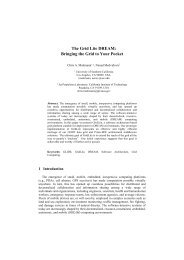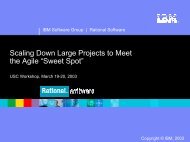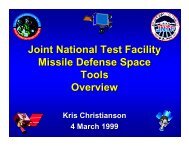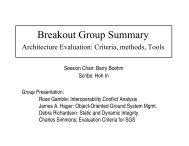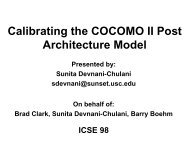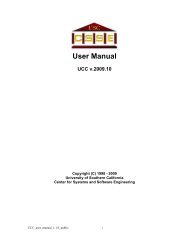Applying CCSDS Standards to the Air Force Satellite Control ...
Applying CCSDS Standards to the Air Force Satellite Control ...
Applying CCSDS Standards to the Air Force Satellite Control ...
Create successful ePaper yourself
Turn your PDF publications into a flip-book with our unique Google optimized e-Paper software.
Global Science & Technology<br />
<strong>Applying</strong> <strong>CCSDS</strong> <strong>Standards</strong><br />
<strong>to</strong> <strong>the</strong><br />
<strong>Air</strong> <strong>Force</strong> <strong>Satellite</strong> <strong>Control</strong> Network<br />
(AFSCN)<br />
James Noles and John Pietras,<br />
Global Science and Technology, Inc.<br />
GSAW 2002<br />
The Aerospace Corporation<br />
El Segundo, CA<br />
March 13-15, 2002
13-15 March 2002<br />
AFSCN Interest in <strong>CCSDS</strong><br />
<strong>Standards</strong><br />
• AFSCN interest in <strong>CCSDS</strong> standards<br />
Global Science & Technology<br />
– The AFSCN is investigating <strong>the</strong> feasibility of evolving from a<br />
circuit-switched network architecture <strong>to</strong> an IP packet-switched<br />
architecture<br />
– The AFSCN has a longer-range interest in assessing <strong>the</strong><br />
suitability of <strong>CCSDS</strong> link pro<strong>to</strong>cols, SLE services, and SCPS<br />
» Greater use of commercial products and services<br />
» Interoperability with NASA and o<strong>the</strong>r TT&C networks<br />
– Issues affecting application of SLE in AFSCN<br />
» Current AFSCN client spacecraft don’t use <strong>CCSDS</strong> link<br />
pro<strong>to</strong>cols and data units<br />
• SLE services are formally based on <strong>the</strong> <strong>CCSDS</strong> link pro<strong>to</strong>cols<br />
• Slow turnover of spacecraft means legacy space link<br />
pro<strong>to</strong>cols must be supported for many years<br />
» Tight latency and timing-preservation requirements<br />
– Can SLE infrastructure be “stretched” <strong>to</strong> cover AFSCN legacy<br />
clients?<br />
» Ease transition <strong>to</strong> use of <strong>CCSDS</strong> link pro<strong>to</strong>col and<br />
interoperability with o<strong>the</strong>r TT&C networks<br />
2
Current AFSCN TT&C Block<br />
Diagram<br />
Global Science & Technology<br />
SV<br />
HPA<br />
Command<br />
Signals<br />
Tracking<br />
Angles<br />
Remote Tracking Station (RTS)<br />
Receiver Demodula<strong>to</strong>r Bit Sync.<br />
Antenna<br />
<strong>Control</strong><br />
Unit<br />
Modula<strong>to</strong>r<br />
Error Signals<br />
UL Sig.<br />
Gen.<br />
Commands<br />
<strong>Control</strong> &<br />
Status<br />
Processor<br />
Time Code<br />
Genera<strong>to</strong>r<br />
PCM Code<br />
Converter<br />
Commands<br />
Timing<br />
Signals<br />
Telemetry<br />
Bit Streams<br />
Communications Link<br />
MUX<br />
DEMUX<br />
DSCS or<br />
DOMSAT<br />
Contact<br />
Support &<br />
Planning<br />
Processors<br />
Time-tagging<br />
Decommutation<br />
Timing Signals<br />
Frame Sync.<br />
Decryption<br />
DEMUX<br />
Human-<br />
Computer<br />
Interface<br />
Operation<br />
Confirmation<br />
Commands<br />
Interface<br />
Units<br />
Commands<br />
MUX<br />
<strong>Satellite</strong> Operations <strong>Control</strong> Center (SOC)<br />
Diagram taken from “AFSCN Comm Requirements”, Krikorian, Y.Y., et al, 12 April 2001,<br />
The Aerospace Corporation<br />
13-15 March 2002<br />
3
AFSCN SLE-Based TT&C Block<br />
Diagram<br />
Global Science & Technology<br />
SV<br />
HPA<br />
Command<br />
Signals<br />
Tracking<br />
Angles<br />
Remote Tracking Station (RTS)<br />
Receiver Demodula<strong>to</strong>r Bit Sync.<br />
Antenna<br />
<strong>Control</strong><br />
Unit<br />
Modula<strong>to</strong>r<br />
Error Signals<br />
UL Sig.<br />
Gen.<br />
Commands<br />
<strong>Control</strong> &<br />
Status<br />
Processor<br />
Time Code<br />
Genera<strong>to</strong>r<br />
PCM Code<br />
Converter<br />
Commands<br />
Timing<br />
Signals<br />
Telemetry<br />
Bit Streams<br />
Communications Link<br />
Unframed<br />
Service<br />
Provider<br />
Block<br />
Command<br />
Service Provider<br />
Unframed<br />
SLE-PDUs<br />
Block<br />
Command<br />
SLE-PDUs<br />
Internet<br />
Contact<br />
Support &<br />
Planning<br />
Processors<br />
Human-<br />
Computer<br />
Interface<br />
Time-tagging<br />
Operation<br />
Confirmation<br />
Decommutation<br />
Commands<br />
Timing Signals<br />
Frame Sync.<br />
Interface<br />
Units<br />
Decryption<br />
Commands<br />
Unframed<br />
Service<br />
User<br />
Block<br />
Command<br />
Service<br />
User<br />
Unframed<br />
SLE-PDUs<br />
Block<br />
Command<br />
SLE-PDUs<br />
<strong>Satellite</strong> Operations <strong>Control</strong> Center (SOC)<br />
NOTE: New services needed <strong>to</strong> transfer tracking, antenna pointing, and RTS status and control data flows<br />
are not being addressed during Phase 1<br />
13-15 March 2002<br />
4
SLE-Based Services <strong>to</strong> Support<br />
AFSCN Legacy Missions<br />
Global Science & Technology<br />
• Pro<strong>to</strong>type production extensions <strong>to</strong> compensate for legacy<br />
environment<br />
– Unframed Telemetry service <strong>to</strong> deliver bitstreams across a<br />
packet-switched wide area network<br />
» Provide accurate “telemetry received” time over separate<br />
channel (IRIG-B)<br />
– Block Command service <strong>to</strong> transfer block commands from <strong>the</strong><br />
SOC <strong>to</strong> <strong>the</strong> RTS<br />
» Processing involves receiving continuous data stream of<br />
command blocks and idle fill, extracting and transmitting<br />
command blocks and inferred timing requirements, and<br />
reconstructing <strong>the</strong> command data stream with proper<br />
release timing<br />
– Command Stream service <strong>to</strong> transfer all bits (including idle bits)<br />
from SOC <strong>to</strong> RTS with consistent delay<br />
13-15 March 2002<br />
5
GST Testbed Activity<br />
Global Science & Technology<br />
• Beginning in June 2001, USAF funded a testbed activity at<br />
GST <strong>to</strong> evaluate TCP, UDP and SLE-based approaches <strong>to</strong><br />
supporting current-day client space vehicles<br />
• Fundamental approach <strong>to</strong> compensate for varying delay<br />
through packet-switched networks<br />
– Transfer of data in minimum time<br />
– Annotation of data <strong>to</strong> allow recovery of timing aspects of data<br />
at <strong>the</strong> receiving end<br />
– Buffering of data at receiving end until time <strong>to</strong> release<br />
– Release of data in accordance with timing information<br />
– “Fill data” mechanisms if data fails <strong>to</strong> arrive in a timely manner<br />
13-15 March 2002<br />
6
GST Testbed Activity (concluded)<br />
Global Science & Technology<br />
• SLE-based services built on existing NASA Jet Propulsion<br />
Labora<strong>to</strong>ry (JPL) SLE API software<br />
• Minimal-capability TCP and UDP pro<strong>to</strong>types establish<br />
baseline measurements for use of internet pro<strong>to</strong>cols <strong>to</strong><br />
transfer bitstream and time-critical blocked data<br />
• Testbed configurations<br />
– Unframed telemetry over TCP or UDP<br />
– Unframed telemetry over SLE RAF<br />
– Block command over TCP<br />
– Block command over SLE CLTU<br />
• Experimentation with COTS IPsec (3DES)<br />
• Performance measurements include:<br />
– Delay and delay variation<br />
– Data loss and sequence errors (when using UDP)<br />
– Overhead<br />
– Time tagging accuracy<br />
13-15 March 2002<br />
7
Unframed Telemetry over RAF:<br />
GST Testbed Configuration<br />
Global Science & Technology<br />
GPS signal<br />
Time<br />
Server<br />
Network Time Pro<strong>to</strong>col<br />
IRIG<br />
Data<br />
Genera<strong>to</strong>r<br />
serial<br />
IRIG<br />
time<br />
signal<br />
serial<br />
bitstream<br />
Blocker<br />
Processor<br />
RTS<br />
RAF<br />
Provider<br />
R<br />
T<br />
R<br />
w/<br />
I<br />
RAF<br />
User<br />
Re-serializer<br />
Processor<br />
Data<br />
Receiver<br />
IRIG sys<br />
sys<br />
IRIG IRIG<br />
clock<br />
clock<br />
buffer<br />
IRIG<br />
time<br />
signal<br />
serial<br />
bitstream<br />
IP/ IP/ IP/<br />
P WAN P<br />
IP/ IP/ IP/<br />
serial s<br />
s<br />
eth eth eth<br />
eth eth eth<br />
serial serial<br />
e<br />
c<br />
simula<strong>to</strong>r<br />
R<br />
T<br />
R<br />
w/<br />
I<br />
e<br />
c<br />
SOC<br />
13-15 March 2002<br />
8
Results and Observations<br />
Global Science & Technology<br />
• Performance<br />
– TCP met a delay goal of 1.25 seconds for lower data rates and<br />
network delay/error values. Higher rates and/or network<br />
propagation delays required additional delay <strong>to</strong> ensure reliable<br />
delivery.<br />
» Standard TCP slow start, congestion recovery, and<br />
retransmission window size are largely responsible for<br />
observed performance limits<br />
» Preliminary tests with variants of TCP, such as Vegas and<br />
Tranquility (SCPS-TP), improved performance<br />
– SLE RAF performance is marginally less than that of straight<br />
TCP, but not prohibitively so<br />
» Delay needed averages 194 millisec more for RAF than<br />
TCP for comparable network delays and error rates<br />
» Due <strong>to</strong> added complexity of RAF software and state<br />
machine, but also artifacts of testbed configuration (e.g.,<br />
distributed processing across multiple processors)<br />
13-15 March 2002<br />
9
• Performance (concluded)<br />
13-15 March 2002<br />
Results and Observations<br />
(concluded)<br />
Global Science & Technology<br />
– IPsec pro<strong>to</strong>col (with 3DES) has negligible effect on performance<br />
» No multiplication of packet loss, insignificant added delay<br />
» Performance in real-world situations will depend on<br />
selection of services (e.g., au<strong>the</strong>ntication, privacy, etc.) and<br />
security algorithms, which will be mission-dependent<br />
• Applicability of SLE services <strong>to</strong> AFSCN<br />
– SLE services allow for annotations (e.g. timestamps) <strong>to</strong> be<br />
added in a standardized and interoperable way, but benefits of<br />
o<strong>the</strong>r capabilities of SLE depend on upgrade of SOC and RTS<br />
processing systems<br />
» Legacy command and telemetry processing systems have<br />
no way of handling SLE notifications and reports<br />
» Upgrade of command and telemetry processing systems<br />
could utilize SLE notifications and reports, even while <strong>the</strong><br />
format of <strong>the</strong> spacecraft data itself remains unchanged<br />
– To provide interoperability of legacy support services,<br />
standardization of <strong>the</strong> blocking and time correlation functions is<br />
just as important as <strong>the</strong> transfer service interface specifications<br />
10
Next Steps<br />
Global Science & Technology<br />
• GST is incorporating in<strong>to</strong> <strong>the</strong> pro<strong>to</strong>types some of <strong>the</strong><br />
enhancements identified in Phase 1<br />
• GST will install pro<strong>to</strong>type systems at <strong>the</strong> QRD (Kirtland AFB)<br />
and CERES SOC (Schriever AFB) in March/April<br />
– Tests and demonstrations in late spring/summer<br />
• Longer-term follow-on testbed activities may include fur<strong>the</strong>r<br />
refinements of enhanced SLE and TCP/UDP services,<br />
experimentation with SLE service management, and<br />
experimentation with <strong>the</strong> Space Communications Pro<strong>to</strong>col<br />
<strong>Standards</strong> (SCPS)<br />
13-15 March 2002<br />
11


